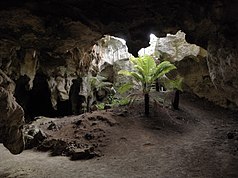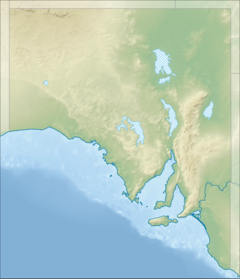Naracoorte Caves National Park
| Naracoorte Caves National Park | ||
|---|---|---|
| Naracoorte Caves National Park | ||
|
|
||
| Location: | South Australia , Australia | |
| Specialty: | Fossils | |
| Next city: | Naracoorte | |
| Surface: | 3.05 km² | |
| Founding: | 1994 | |
| Skeleton of a marsupial lion ( Thylacoleo carnifex ) in the Victoria Fossil Cave in Naracoorte Caves National Park | ||
The Naracoorte Caves National Park is a national park in the southeast of the Australian state of South Australia , 313 km southeast of Adelaide , 83 km north of Mount Gambier and 15 km southeast of Naracoorte . In 1994 the area was declared a national park because of its extraordinarily extensive fossil record and was classified as a UNESCO World Heritage Site along with Riversleigh in Queensland . 6 km² of remaining vegetation in the park is protected; the world natural heritage area contains 26 caves on an area of 3.05 km².
Facilities and sights
The park is a tourist attraction and has a campground, RV park, group accommodation, picnic areas and a café. The number of sights is huge. Cave tours are offered by trained guides. There you can see caves that are filled with a large number of interesting fossils. Modern technology can be used to show visitors the inside of the normally inaccessible Bat Cave , where thousands of bats breed every year. There are also cave tours for adventurers, a number of special tours and special events.
Emergence
The limestone in the area was formed by corals and other marine life 200 million years ago and again about 20 million years ago when the land was again below sea level. Since then, groundwater has loosened part of the limestone, creating the caves. These caves, such as the Victoria Fossil Cave or the Blanche Cave , are often not far underground and holes opened that posed dangers to the careless. This created a remarkable collection of fossils. Mammals and other land creatures fell into the open holes and were unable to escape. The fossils were preserved in banks of earth washed and blown from the surface of the earth. In some places the fossil-bearing layer is up to 20 m thick. Some of these areas will be saved for future exploration when better methods of dating and reconstructing fossil finds become available. The fossil traps are particularly important for research into the Australian megafauna .
Web links
- Official website
- Australian Fossil Mammal Site - Naracoorte . Department of Sustainablity, Environment, Water, Population and Communities. Australian Government
- Australian Fossil Mammal Sites - (Riversleigh / Naracoorte) . UNESCO
- Naracoorte Visitor Information Center . Naracoorte Lucindale Tourism
- Photos of the Naracoorte Caves by Andrew McMillan
- Entry on the UNESCO World Heritage Center website ( English and French ).
source
Naracoorte Caves . ParksWeb: Wonambi Fossil Center. Australian Government
literature
Joel Achenbach: Lost Giants . National Geographic. Issue 4, Volume 218 (October 2010). Pp. 90-109
Individual evidence
- ^ Steve Parish: Australian Touring Atlas . Steve Parish Publishing Pty. Ltd. Archerfield QLD (2007). ISBN 978174193232-4 . P. 69



